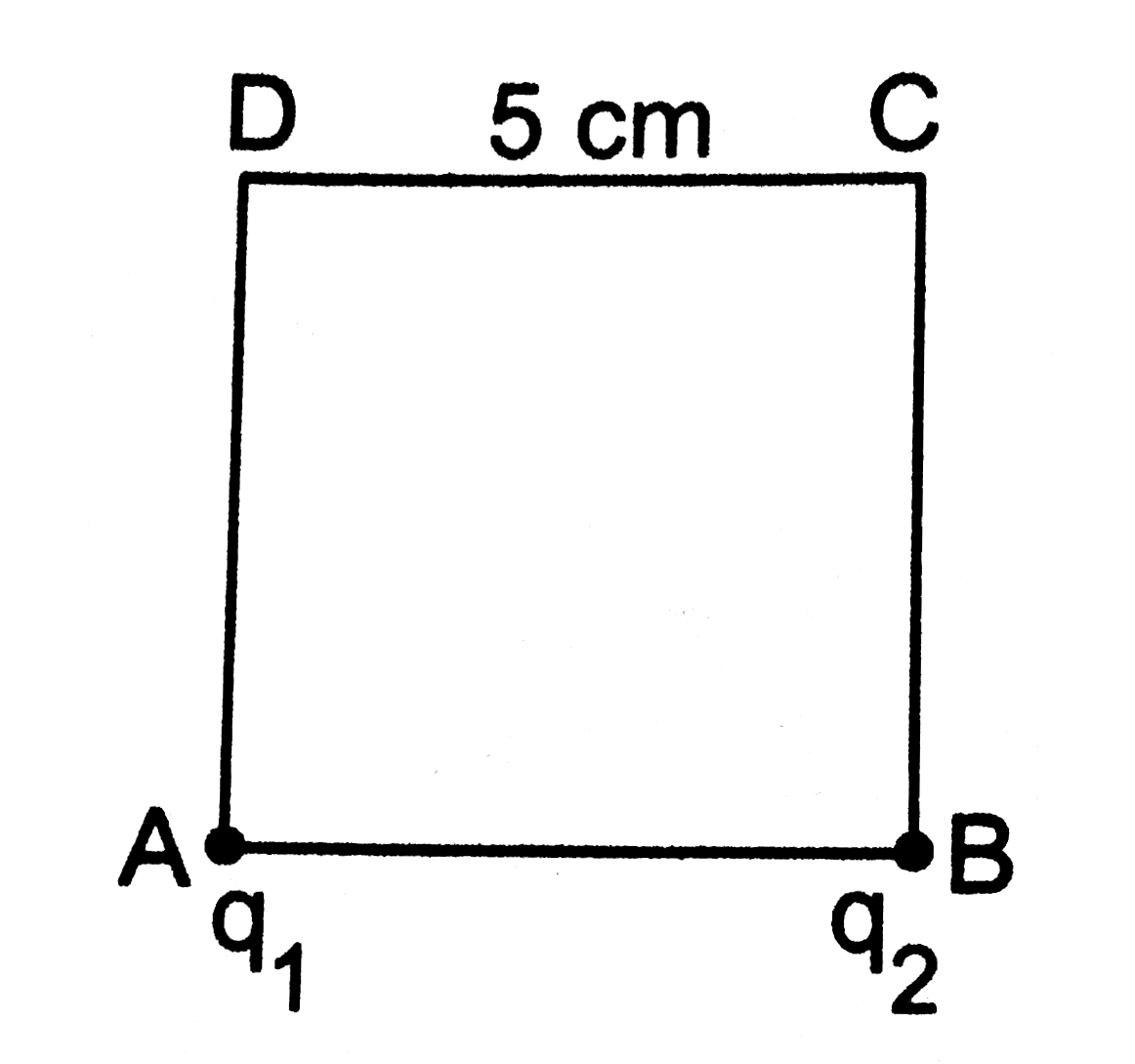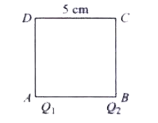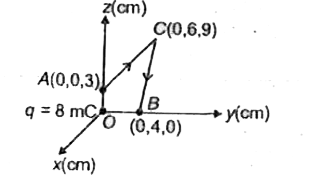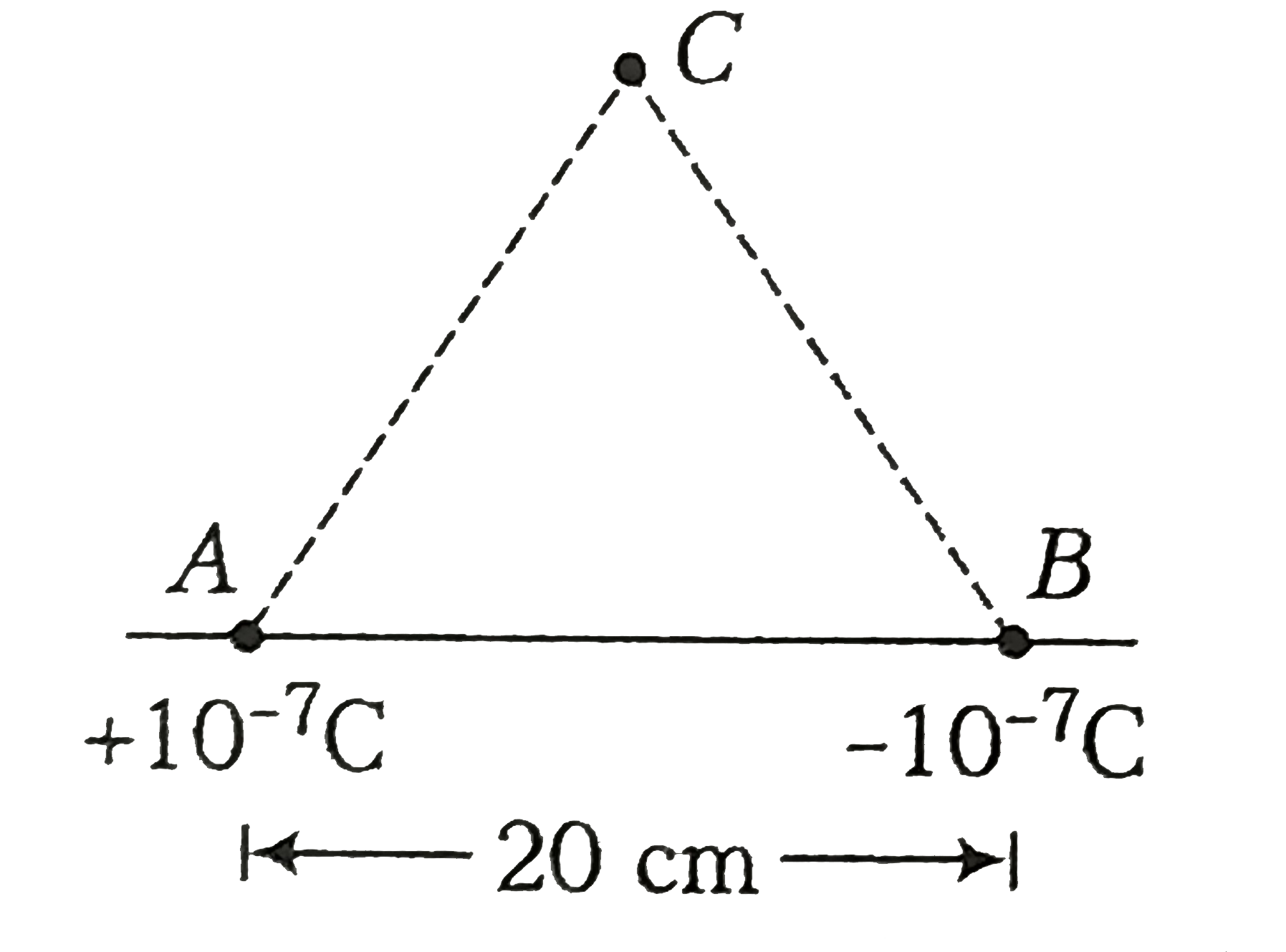charges 2.0×10−6C and 1.0×10−6C are placed at. corners A and B of a squae of side 5.0cm as shown in. figure .how much work will be done against. the electric field in moving a charge of 1.0 xx 10^(-6) C from. C to D?.

The electric potential at C
=14πε0(q1AC+q2BC)
=9×109Nm−2C(−2)⎛⎜⎝2.0×10(−6)C√2×0.05m+1.0×10(−6)C0.05m
=(9000V)(2+√2√2×0.05)
. The electric potential at D
=14πε0(q1AD+q2BD
=9×109Nm−2C(−2)(2.0×10(−6)C0.05m+1.0×10(−6)C√2×0.05m)
=(9000V)(2√2+1√2×0.05)<br>.Theworkdo≠aga∈stthee≤ctricfield∈mov∈gthe<br>char≥1.0xx 10(-6)CimC→disq(V_D- V_C)<br>= (1.0xx 10(-6) C)(900V) ((2sqrt2+1-2-sqrt2)/(sqrt2 xx o.05))
=0.053J
Topper's Solved these Questions
- ELECTRIC FIELD AND POTENTIALBOOK - HC VERMACHAPTER - ELECTRIC FIELD AND POTENTIALEXERCISE - Short Answer
14 Videos
- ELECTRIC FIELD AND POTENTIALBOOK - HC VERMACHAPTER - ELECTRIC FIELD AND POTENTIALEXERCISE - Objective 1
9 Videos
- ELECTRIC FIELD AND POTENTIALBOOK - HC VERMACHAPTER - ELECTRIC FIELD AND POTENTIALEXERCISE - Exercises
75 Videos
- ELECTRIC CURRENT THROUGH GASESBOOK - HC VERMACHAPTER - ELECTRIC CURRENT THROUGH GASESEXERCISE - Exercises
23 Videos
- ELECTROMAGNETIC INDUCTIONBOOK - HC VERMACHAPTER - ELECTROMAGNETIC INDUCTIONEXERCISE - EXERCISE
9 Videos
Similar Questions
Charges 2×10−6Cand1×10−6C are placed at comers A and B of a square of side 5 cm as shown in the figure. How much work will be done against the electric field in moving a charge of 1×10−6C from C to D?

View SolutionCharges 5.0×−7Cand1.0×10−7C are
held fixed at the three cornners A, B, C of an equilateral
. charge at C due to the rest two.
View Solution
Knowledge Check
Calculate the work done in taking a charge −2×10−9C from A to B via C (in diagram )
 A0.2 jouleB1.2 jouleC2.2 jouleDzero
A0.2 jouleB1.2 jouleC2.2 jouleDzeroCharges of +103×10−9C are placed at each of the four corners of a square of side 8cm. The potential at the intersection of the diagonals is
A150√2 voltB1500√2 voltC900√2 voltD900 voltTwo charges 4×10−8C and −6×10−8C are at points A and B respectively ,50cm apart . The electrical potential due to them is zero on the line AB at a distance from A equal to
A10cmB20cmC30cmD40cm
calculate the electric field at point (5 m, 0) due to a point charge of 1 x 10(-6) C placed at (0,5m).
View SolutionFour equal charges 2.0×10−6C each are fixed at the four corners of a squae of side 5 cm. Find the coulomba force eperienced by one of the charges due to the rest three.
View SolutionFind the magnitude of the electric field at a point 4 cm away from a line charge of density 2×10−6Cm−1.
View SolutionTwo particles A and B, having opposite charges2.0×10−6 and −2.0×10−6C , are placed at a separaton of 1.0 cm.(b) Calculate the electric field at a point on the axis of the dipole 1.0 m away from the centre. (c ) Calculate the electric field at a point on the perpendicular bisector of the dipole and 1.0 m away from the centre.
View SolutionTwo point charges +10−7C and −10−7C are placed at A and B 20 cm apart as shown in the figure. Calculate the electric field at C, 20 cm apart from both A and B.

View Solution
